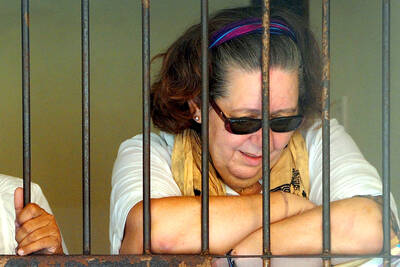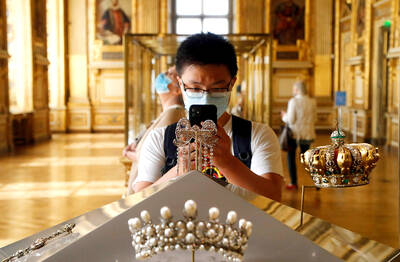Conservationists are rushing to save what is left of Beirut’s architectural heritage, which has fallen victim to greedy promoters and politicians accused of turning the Lebanese capital into a concrete jungle.
“Beirut used to be a city of gorgeous mansions and gardens and now it has become a boring heap of high-rises and construction projects,” said Yvonne Sursock Cochrane, 88, founder of the Association for Protecting Natural Sites and Old Buildings in Lebanon (APSAD).
“We are destroying old houses which in other countries no one would dare touch,” said Cochrane, whose family owns one of Beirut’s most beautiful Ottoman-era mansions.

PHOTO: AFP
As building cranes crowd the city skyline, Beirut’s typical Lebanese houses, with their triple-arched windows, elaborate balconies, red-tiled roofs and jasmine-scented gardens have all but disappeared in favor of high-rises sprouting like mushrooms.
Of 1,200 old mansions and buildings inventoried in 1995 by the culture ministry, a mere 400 are left, officials say.
The construction boom, which began at the end of the 1975 to 1990 civil war, is largely fueled by rich expatriates and Gulf Arab investors who have driven prices up, encouraging Beirut property owners to sell to the highest bidder.
“Beirut is becoming uglier by the day and the Lebanese are getting used to this ugliness,” said Pascale Ingea, a member of Save Beirut Heritage, an initiative launched this year on the social networking Internet site Facebook.
“I felt I had to do something when I watched from my balcony a 200-year-old mansion that used to make me dream when I was a child being torn down, stone by stone,” the 33-year-old artist said.
“Our social and urban fabric are disappearing,” she added. “Beirut is no longer the city we knew.”
One property developer whose company is building a luxury high-rise in the Sursock neighborhood of Beirut, which was once lined with elegant mansions and where a flat can now fetch upwards of US$3 million, declined to comment.
“I am embarrassed because we tore down a traditional house to build a tower,” he said, requesting anonymity. “What else can I say?”
Although many feel it may be too late to halt the rot, conservationists are pushing ahead with efforts to save the few buildings still standing.
One recent television spot by conservation groups featured tombstones representing demolished buildings against a backdrop of skyscrapers and a message that urged parliament to pass legislation to preserve heritage houses.
Any demolition order in Beirut must now carry the signature of Lebanese Culture Minister Salim Wardy, who recently set up a hotline for people to report threatened buildings.
“This has significantly reduced demolitions,” Wardy said.
But what is needed most, conservationists say, is the political will to preserve what is left.
“Lebanon considers itself a pioneer in everything, but when it comes to this we are way behind other Arab countries,” Wardy said.
Architect Fadlallah Dagher, a member of APSAD, said given that many of Lebanon’s politicians also dabble in property, it should come as no surprise that draft legislation to protect the country’s architectural heritage has been sitting in parliament for eight years.
“It’s no secret in Lebanon that a lot of politicians are in real estate and have no interest to safeguard old homes,” Dagher said, sitting in his family villa in Beirut’s traditional neighborhood of Gemayzeh.
“Where there is land, there is money to be made,” he added. “I was once told by real estate developers not to meddle in their affairs and to go elsewhere if I was looking for culture.”
Wardy acknowledged that he had come under intense pressure by politicians and developers to take bribes and turn a blind eye to the destruction.
“We’re simply trying to preserve the identity of our city,” he said. “We’re trying to save what is left.”

Indonesia was to sign an agreement to repatriate two British nationals, including a grandmother languishing on death row for drug-related crimes, an Indonesian government source said yesterday. “The practical arrangement will be signed today. The transfer will be done immediately after the technical side of the transfer is agreed,” the source said, identifying Lindsay Sandiford and 35-year-old Shahab Shahabadi as the people being transferred. Sandiford, a grandmother, was sentenced to death on the island of Bali in 2013 after she was convicted of trafficking drugs. Customs officers found cocaine worth an estimated US$2.14 million hidden in a false bottom in Sandiford’s suitcase when

CAUSE UNKNOWN: Weather and runway conditions were suitable for flight operations at the time of the accident, and no distress signal was sent, authorities said A cargo aircraft skidded off the runway into the sea at Hong Kong International Airport early yesterday, killing two ground crew in a patrol car, in one of the worst accidents in the airport’s 27-year history. The incident occurred at about 3:50am, when the plane is suspected to have lost control upon landing, veering off the runway and crashing through a fence, the Airport Authority Hong Kong said. The jet hit a security patrol car on the perimeter road outside the runway zone, which then fell into the water, it said in a statement. The four crew members on the plane, which

Japan’s ruling Liberal Democratic Party (LDP) and its junior partner yesterday signed a coalition deal, paving the way for Sanae Takaichi to become the nation’s first female prime minister. The 11th-hour agreement with the Japan Innovation Party (JIP) came just a day before the lower house was due to vote on Takaichi’s appointment as the fifth prime minister in as many years. If she wins, she will take office the same day. “I’m very much looking forward to working with you on efforts to make Japan’s economy stronger, and to reshape Japan as a country that can be responsible for future generations,”

SEVEN-MINUTE HEIST: The masked thieves stole nine pieces of 19th-century jewelry, including a crown, which they dropped and damaged as they made their escape The hunt was on yesterday for the band of thieves who stole eight priceless royal pieces of jewelry from the Louvre Museum in the heart of Paris in broad daylight. Officials said a team of 60 investigators was working on the theory that the raid was planned and executed by an organized crime group. The heist reignited a row over a lack of security in France’s museums, with French Minister of Justice yesterday admitting to security flaws in protecting the Louvre. “What is certain is that we have failed, since people were able to park a furniture hoist in the middle of